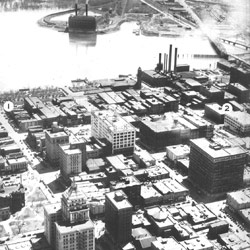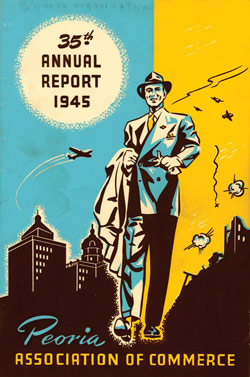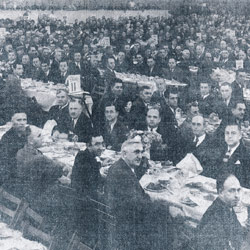
The Peoria Area Chamber of Commerce turns a century old in 2011.
In 1911, a group of businesspeople with a strong faith in community came together to form the Peoria Association of Commerce. In a publication produced by the Association the following year, the statement was made that “The sun never sets on Peoria manufactured products.”
Manufacturing has been Peoria’s stock in trade over the years due to geographic advantages like the Illinois River, but also because of a business climate that’s been marked by both cooperation and innovation, a spirit fostered today by the Peoria Area Chamber of Commerce.
Over the years, Peoria’s industries have included many familiar names: Keystone Steel and Wire Co., LeTourneau Westinghouse Co., Caterpillar Tractor Co. (now Caterpillar Inc.), Hiram Walker & Sons, Inc., Pabst Brewing Co., Bemis Bag Co., Hyster Co. and Commercial Solvents Corp. While some of these businesses are gone, the names linger on. The area’s single largest employer remains Caterpillar Inc., a company that has grown into a multinational powerhouse yet still makes Peoria its home, with plans to soon build a visitors center on its riverfront.
Business in central Illinois is ever-changing. In the distilling center that housed the Hiram Walker plant—once considered the world’s largest distillery—Archer Daniels Midland now processes grain for ethanol fuel. Previously a major livestock market in the Midwest, Peoria’s stockyards have given way to a new growth center: its cutting-edge medical community.
In the 21st century, technology has entered the scene, and smaller companies with new ideas are having an impact. The Peoria NEXT Innovation Center that opened on Main Street in 2007 is testimony to the concept that in the Information Age, you can’t stand pat.  Committed to Business
Committed to Business
The Peoria Area Chamber of Commerce remains committed to business in all forms—from the large corporation to the mom-and-pop shop. That commitment was in evidence in the Association’s first newsletter published back in 1911.
A chamber of commerce stands for many things: attracting new business, helping existing businesses develop and working to build a strong local economy. But it starts with civic pride. That first newsletter still rings true today: “Peoria is famed for many things. She is beautiful for situation. America can show nothing of its kind more attractive than the valley of the Illinois River…the city itself, its foliage, its homes, its avenues, is lacking in nothing that commends a home city.”
In 1913, the Association newsletter asked, “Why should Peoria not be a retail center, situated in one of the richest communities the sun ever shone upon; rich in fertile soil that will produce almost anything that ever grew out of the ground, rich in abundance of fuel right under our feet; rich in any quantity of pure water; good for any purpose, even to drink; rich in a diversified population of progressive, industrious and thrifty people?”
Year after year, the Chamber has led the way to greater achievements for the business community and the region. As always, those achievements are the result of teamwork and the contributions of those willing to give both time and energy to benefit the community. In recent years, the following individuals have chaired the Chamber board: Jack Russell (1992-93), Jim Broadway (1994-95), Don White (1995-96), Becky Auer (1996-97), Jack Gilligan (1997-98), Mike Quine (1998-99), Bruce Alkire (1999-2000), John Sahn (2000-01), Sandra Birdsall (2001-03), Larry Clore (2003-04), Jim Montelongo (2004-05), Tim Elder (2005-06), Mary Ardapple (2006-07), Roger Lakin (2007-08), Debbie Ritschel (2008-09), Charles Purcell (2009-10) and the current chairman, Mike Wiesehan.
In 1917, the Peoria Association of Commerce cited 10 benefits to membership. They were:
- to serve as a clearinghouse for information to the business community
- to build the city of Peoria
- to foster cooperation that brings “brick and mortar”
- as a moral obligation to one’s city
- to save businessmen money
- to prevent problems
- to work continuously to plant industries
- to provide promotional work that is valuable
- to stay in close touch with “big affairs”
- to submerge individual interests.
Despite all the changes in our world since that time, the list stands up well today.
Business success stories have been common in the Peoria area over the past century, many of them chronicled by the Association of Commerce. The May 1913 newsletter notes that “the P.A. Bergner Co., eight short years ago, occupied one room on the Fulton side of the Woolner building. Now they occupy more than 40,000 square feet of floor space and have doubled their business many times.”
From another early newsletter: “About two years ago, the Peoria Merchants Association took up the matter of lighting the retail district with ornamental electric streetlights, with the result that the newborn year 1912 will soon be blinding its baby eyes in the glaring light of 30 blocks of blazing glory.”
Back when Peoria’s retail business center was located downtown, the association’s Special Store Hours Committee set Christmas shopping hours for the week preceding Christmas. In 1950, the committee approved extending shopping hours on December 21st and 22nd of that year all the way to 8:30pm, instead of the traditional 5pm. The shopping frenzy that must have ensued!
 Concerns Past and Present
Concerns Past and Present
Leadership is a hallmark of the Chamber of Commerce. In 1932, Association members raised funds for a new Peoria airport after the Depression-era electorate twice turned down referendums to construct a facility that would accommodate the larger planes of the day. Although most people traveled by rail at that time, it was the far-sighted business community that recognized air travel’s potential and its importance to the Peoria area.
Transportation has long been a major concern of the Association, and later, the Chamber. Peoria’s transportation history runs deep; the first steamboat came to Peoria in 1830 and the first steam train arrived in 1854. Later, the arrival of the automobile was greeted with enthusiasm by Peoria business. One of the first committees of the Peoria Association of Commerce was the Good Roads Committee that pioneered Galena Road to Chillicothe, the first paved highway in the area.
Chamber President Roberta Parks points to continued efforts on the part of the business community to promote transportation in the Peoria area. “The modernization of the I-74 interstate was a major project for this area,” said Parks, who joined the Chamber’s transportation committee on a recent tour of the Peoria airport’s new $65 million passenger terminal.
Agriculture remains a major activity across central Illinois, a fact long recognized by the Association of Commerce. In its first year of existence, the Association formed a committee to raise funds to assure the formation of a Peoria County Farm Bureau. In 1937, its first agriculture committee was formed, with Harry Neumiller as president. One of the committee’s first activities was to secure sites for the proposed Northern Regional Research Laboratory while helping the lab locate here. The Ag Lab, as it’s now known, was built in 1940 at a cost of $2 million. The U.S. Department of Agriculture facility remains a pillar in the scientific community, having led the way in agricultural research over the years with breakthroughs that have impacted the worlds of food, fuel and medicine.
Helping to bring another institution to the Peoria area was the concern of Murray Baker, who later served as an Association of Commerce president. In 1909, Baker helped arrange for the Holt Manufacturing Co. of California to purchase the East Peoria Colean Works, which had been constructed 12 years earlier to manufacture steam tractors. When the Holt firm merged with another tractor builder in 1925, the new organization was named Caterpillar Tractor Co. Baker served Holt, and then Caterpillar, in both their operations and on their boards of directors for 50 years.
The Chamber also brought activity to the area in the form of a convention and visitors bureau—now a separate entity—but once the function of the Chamber of Commerce. “When I came there on staff, convention business was about $3.5 million,” said Herbert Johnson, who served as Chamber president from 1953 to 1974. “We built it up to $30 million. We had our own convention department at the Chamber,” he said.
Education is another priority for the Chamber, as exemplified by its leadership in the drive to establish the city’s first charter school, which opened last fall, as well as the long-running Community Leadership School and Adopt-A-School programs. Education also takes the form of helping Chamber members and the general public share information on a regular basis. In 1985, the Chamber launched the Area Business Connection (now known as the Peoria Area Business Showcase), a trade show staged each spring at the Peoria Civic Center that helps area businesses network with each other. This was an outgrowth of another Chamber campaign, “Try Your Peoria Area First,” which sought to keep more business dollars in the Tri-County Area.
To get a real sense of the importance of the Chamber in the community, one need only attend its annual Thanksgiving Community Luncheon, where hundreds of members give thanks before the holiday and recognize the contributions of outstanding individuals and businesses. That celebration of community service carries on a historic tradition voiced earlier in a 1949 newsletter: “Awareness of a civic responsibility to contribute to a better Peoria of tomorrow causes individuals and business firms alike to seek out the most effective way of assuring a better Peoria for our future citizens.”
The Peoria Association of Commerce—today known as the Peoria Area Chamber of Commerce, part of The Heartland Partnership—has been taking care of business for 100 years. In looking back at some of the history, you understand the importance of organization, cooperation and restless ingenuity. Those are the things that have made Peoria great in the past and look to bring it success in the future. iBi
 » 100 Years Ago…
» 100 Years Ago…
After just three months of existence, the Peoria Association of Commerce issued Vol. 1, No. 1 of its newsletter, The Peorian, in June 1911. The Association’s major priority at the time was the development of a national show to highlight Peoria’s status as the agricultural implement manufacturing center of the world:
It is conceded that a strictly implement and vehicle show, of national character, will be eagerly and generally patronized by the implement and vehicle dealers throughout the central west.
With the interest and support such a project would receive by Peoria businessmen in all lines of trade, and the general feeling that prevails among the manufacturers, the time has arrived for a permanent National Implement and Vehicle Show.
There is every reason for the establishment of such an exposition. It will be a good thing for Illinois. Her magnificent factories, devoted to the manufacture of the large bulk of the world's agricultural machinery, demand it. It is not enough that they be shown at a state fair. The industry is big enough to call for an institution of its own.
Eight years before Prohibition, the newsletter highlights the whiskey-making capacity of Peoria’s distilleries:
There is not a laboratory in the world that is not in all probability using the alcohols made in this city. A train load of the distillant leaves Peoria every night of the year for New York, there to be exported to Europe and all parts of the globe. Whiskey? Considerable. More than Kentucky and the Monongahela districts combined make. The total revenue to the government from the Peoria distilleries amounts to more than thirty millions of dollars per year. For all this is Peoria celebrated.
Nearly 70 years before the creation of the Peoria Area Convention & Visitors Bureau, the Association set up a Conventions Committee to bring these gatherings to Peoria:
The advantages of Peoria for convention purposes are due not alone to her central position in the middle west and the facilities for access to her portals, but as well to the fine halls and meeting places available to any organization of a reputable character for the asking.

